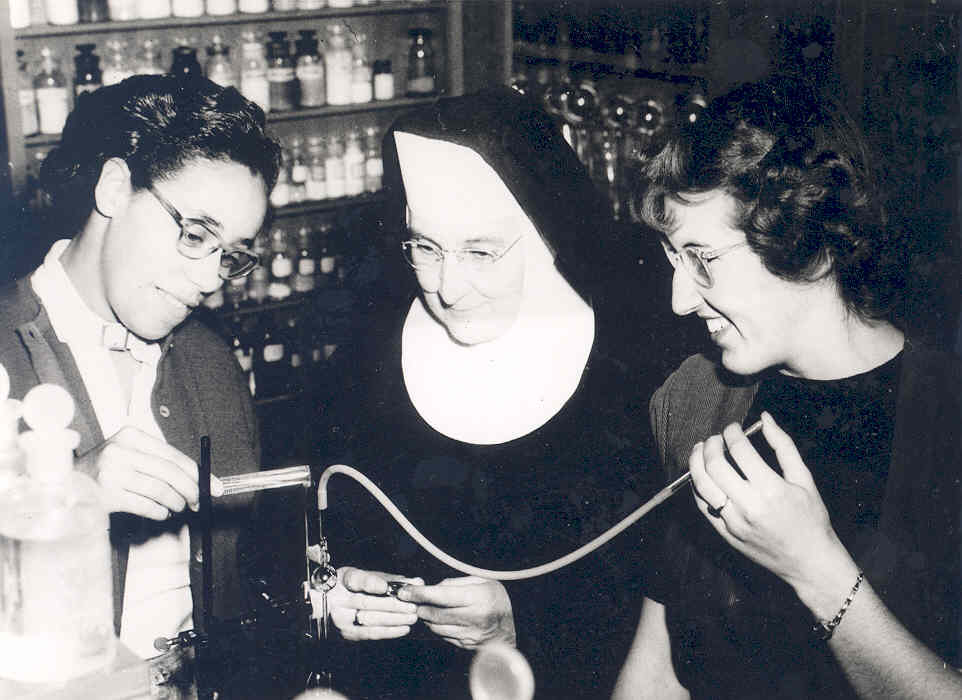When it came to establishing the College of Saint Benedict, “the Benedictine sisters knew that to staff their own college they had to do advanced work themselves. Graduating from the (Saint Benedict’s) Academy, even doing well there, was not enough; they needed college degrees,” noted professor emerita of history Annette Atkins in her book Challenging Women Since 1913.
“And so they turned to friends and relatives – many families had both daughters and sons among the Benedictines – at Saint John’s. … The early paperwork for Saint Ben’s reports that – with the exception of one lay faculty woman who earned a bachelor’s degree in home economics at the University of Minnesota and of Fr. Henry Borgerding, the chaplain and theology teacher – the earliest members of the faculty, all sisters, held Bachelor of Arts degrees from Saint John’s University.
“No one remembers, and neither the Saint John’s nor the Saint Benedict’s archives reveals, how this was accomplished, but it was. No doubt the dozens of sibling connections at Saint Ben’s and Saint John’s helped this project along.”
One of the most ambitious of those early faculty members was Sister Magna Werth. She received her bachelor’s degree in 1914 from Saint John’s University in philosophy, minoring in education.
By 1915 she had earned her Master of Arts from the Catholic University of America and began teaching at Saint Benedict’s Academy and the College of Saint Benedict. In 1931 she received her Ph.D. from the University of Minnesota in physics – one of the first women ever to receive such a degree from the U of M – writing her dissertation on “The Relative Efficiency of Some of the Mercury Arc Lines in Exciting the Ramon Spectrum of Benzol.”
While today 86% of CSB and SJU full-time faculty members hold the highest degree in their field, Sister Magna was a pioneer on that path. She was just the third sister at Saint Ben’s to receive a Ph.D., following Sister Jeannette Roesch (Catholic University, 1918, dissertation title “Vocational Preparation of Youth in Catholic Schools”) and Sister Remberta Westkaemper (University of Minnesota, 1929, thesis title “The Vitamin Content of Some Marine Algae).
At Saint Ben’s, Sister Magna taught physics, chemistry, biology, mathematics and philosophy. In total, she was a member of the CSB faculty for 41 years, from 1915 until 1956.
As a teacher, Sister Magna was meticulous and exacting, with high expectations. Sister Alard Zimmer recalled in the book Threads From Our Tapestry, “Everyone on the faculty with her, it seems, knew that she checked the college calendar as soon as it was released to discover how many classes she would miss because of scheduled free days. They knew, too, that she would complain about missing these classes and that she would expect her students to make up the missed lab sessions either after school or on weekends.”
But Sister Alard personally remembered her as a patient teacher “who wanted her students to succeed and simply would not permit them to fail.
“During lab sessions she would make the rounds, showing obvious delight in the progress of each student. She would tell us about the concepts of physics as if she were relating the latest bit of news, her eyes ever alert for a look of puzzlement or inquiry on any face.”
But as brilliant as Sister Magna was, it’s generally agreed that “she had absolutely no sense of humor and rarely caught on to a joke.” As Sister Alard points out, “People still smile as they remember this woman who, with her keen intellect, apparently had more important things to do than figure out a witticism.”
Sister Magna Werth was both a pioneer and a pillar in College of Saint Benedict history. Her push to quickly earn the education she needed to teach effectively at the college level showcases the spirit of that early faculty. Her commitment to reach the height of her field and earn the Ph.D. demonstrates her drive to provide the best for her students. Her 40+ years of stability and excellence in service to the young college helped build a true culture of academic excellence that lives on.

